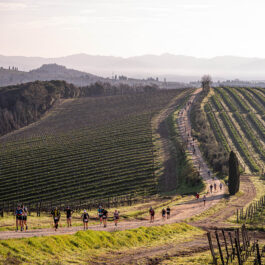Champagne. The word alone evokes a festive feeling, but however much we love this sparkling wine, it comes at a price. True Champagne can only be produced in the Champagne region of France, and as such has an exclusive character that is reflected in the price tag of each bottle. Of course, ‘expensive’ isn’t necessarily a synonym for ‘excellent’, and there’s a whole world of quality sparkling wines worth sipping, all made with just as much dedication and care – even if they don’t have the same cachet. Bonus: they’re often easier on your wallet.
Crémant – France
Let’s start in the same country Champagne comes from. As often as the name ‘Champagne’ drops to refer to any kind of sparkling wine, it can only be called that if the wine comes from the eponymous region and is produced according to strict guidelines. In other French regions where sparkling wine is made using the same method as in Champagne – the méthode traditionelle – they’re called crémants. This method, in a nutshell, involves the wine undergoing a second fermentation in the bottle (hello, bubbles!) and an extended time ageing on the lees, ie. left in contact with the disintegrated yeast cells (hello, toasty, bready aromas!).
Look for a Crémant de Loire, Crémant d’Alsace, Crémant de Bourgogne, Crémant de Bordeaux or Crémant de Limoux (Languedoc). The rules in these appellations are less strict than in Champagne, but only marginally. A range of grape varieties is allowed per appellation: Crémant d’Alsace can be made of Pinot Blanc, Auxerrois, Pinot Gris, Riesling, Chardonnay and Pinot Noir. For the Crémant de Loire, it’s mostly Chenin Blanc, with unique aromas of lemon, pear and honey. Crémant de Bordeaux is the only French appellation that allows the use of Sauvignon Blanc.
Metodo Classico Wines – Italy
Italy also boasts wines that owe their sparkle to a second fermentation in the bottle, or metodo classico in Italian. For sparkling wine there are three appellations: Franciacorta, Trento and Oltrepo Pavese. Franciacorta is located in northern Lombardy, close to Lake Iseo, where Pinot Blanc, Chardonnay, Pinot Noir and Erbamat are made into fabulous sparkling wines – according to strict rules, such as a minimum of 18 months of bottle ripening. In the southern part of Lombardy is Oltrepo Pavese; here, Pinot Noir is the star of the sparkling wine, made into Blanc de Noirs (a white wine made from red grapes) or rosé. Finally, north of Verona is Trento, where fine bubbly is made from Chardonnay and Pinot Nero (Pinot Noir).
Prosecco – Italy
The other, more famous (and dare we say: people-pleasing) sparkling sister of Italy is Prosecco. It’s made in an entirely different way than traditional sparkling wine, explaining the difference in price.
Prosecco is made from the Glera grape variety (changed from the name ‘Prosecco’ to prevent producers in other regions from jumping on the Prosecco train), which is planted in massive quantities in the Veneto region. Most Prosecco is fruity, floral and uncomplicated, with bubbles that die off rather quickly in the glass. Search for Conegliano Valdobbiadene Prosecco Superiore DOCG if you’re looking for something that’s a notch up. The region contributes only a few drops to the Prosecco lake, but it’s worth a try if you can get your hands on a bottle.
Pét-Nat – France (and others)
You’ve maybe heard the cool winos mention ‘pét-nat’, and thought: pét what? It’s short for pétillant naturel, or ‘naturally sparkling’, a way to describe sparkling wines that are made according to the ancestral method.
A kind of precursor of Champagne, if you will, it is moderately sparkling and often cloudy (unfiltered). The bubbles are a result of a first fermentation that is interrupted – when the wine is bottled during fermentation, the remaining sugar and yeast produce alcohol, as well as C02, which cannot go anywhere: voilà. They’re often funky, fresh and food-friendly. The technique is not limited to a certain region, and you’ll find producers in France, Italy (although in Prosecco they refer to the technique as col fondo), Germany, Australia and the US.
Cava – Spain
It’s sometimes hard to fathom that Cava is also made via the classic method, a labour- and time-intensive process that is not always reflected in the price. That’s good news, unless it’s also not necessarily reflected in what’s inside the bottle. Fortunately, beautiful, attentively made Cavas are becoming easier to find, ones that burst of fruit flavours.
Most Cava is from the Penedès region in Catalonia, but you’ll find winemaking areas all over Spain that are allowed to claim the Cava denomination. Penedès is hotter and drier than most other traditional sparkling wine regions, and with a blend of grape varieties Xarel-lo, Parellada and Macabeo, they tend to be earthier and fruitier in comparison to Champagne.
Cap Classique – South Africa
Fifty years ago, Winery Simonsig in Stellenbosch was the first South African wine producer making vonkelwyn in the traditional way, and other wineries quickly followed suit. For the Cap Classique, they’re mostly using the same grape varieties as in Champagne – Chardonnay, Pinot Noir and Pinot Meunier – but you’ll also find versions featuring other grapes such as Chenin Blanc.
A World Of Bubbles
If there’s one lesson to take home here, it’s that pedigree isn’t everything. Even outside of these larger but underappreciated appellations and genres of sparkling wines, there are countless regions and wineries across the globe making bubbly worth raising a glass to.
A small percentage of German fizz, for instance, is made using the traditional method – even more often in Austria, generally from the grape varieties Welschriesling and Grüner Veltliner. In California, producers in Sonoma and Mendocino make great sparkling wines, as well as some in Oregon, predominantly from Pinot Noir and Chardonnay. In the cooler wine-producing regions of Australia, the classic Champagne varieties end up as bubbly, but there are many other styles as well, including sparkling wine made from Shiraz.
So go forth, ye wine-curious, and pop a bottle of something sparkly and new this season.















Sorry, the comment form is closed at this time.